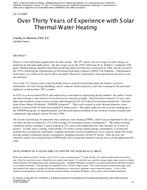Description
History is rich with human applications of solar energy. The 20th century saw two surges in solar energy use, primarily for thermal applications. The first surge was in the 1950’s following M. K. Hubbert’s landmark 1956 paper Nuclear Energy and the Fossil Fuels predicting that oil production would peak by 1969, and the second in the 1970’s following the Organization of Petroleum Exporting Countries (OPEC) Oil Embargo. Unfortunately, both surges were followed by nearly full scale public disinterest, particularly when government incentives were discontinued. Now in the 21st Century with a renewed public interest in good stewardship under the banners of Green, Sustainable, Net Zero Energy Buildings, and/or reduced carbon footprint; solar has reemerged with particular emphasis on photovoltaic (PV) systems.
In 1974, as a newly minted Ph.D. and employed as a mechanical engineering faculty member, the author’s dean ask him to design a solar house to be located on the state fair grounds. That started an intensive 10 year solar effort that included a major action oriented effort funded by the US Federal Government entitled the “National Solar Water Heater Workshop” (NSWHW) program[1]. That work resulted in solar thermal domestic water heaters in much of the US built and installed by homeowners. This paper addresses the activities leading up to the NSWHW program, its implementation, and the performance primarily of one of those systems installed and continuously operating in central PA since 1984.
The lessons learned may be important since domestic water heating (DWH), which was accomplished in this case via solar thermal, accounts for 13% of the average US residential energy consumption[2]. The largest average residential energy consumer is space heating at 25%, also a fine application for solar thermal, be it active or passive. To date, space cooling, representing 13% of the average annual energy consumption, is technically possible but economically challenged. Lighting and minor electrical appliances do account for about 36% of the average annual residential energy consumption, justifying societies current PV thrust. None the less, the relatively steady year around need for DWH makes this second most intensive energy user a prime application for solar.
Citation: ASHRAE Conference Papers, Las Vegas, NV
Product Details
- Published:
- 2011
- Number of Pages:
- 7
- File Size:
- 1 file , 1.8 MB
- Product Code(s):
- D-LV-11-C007




